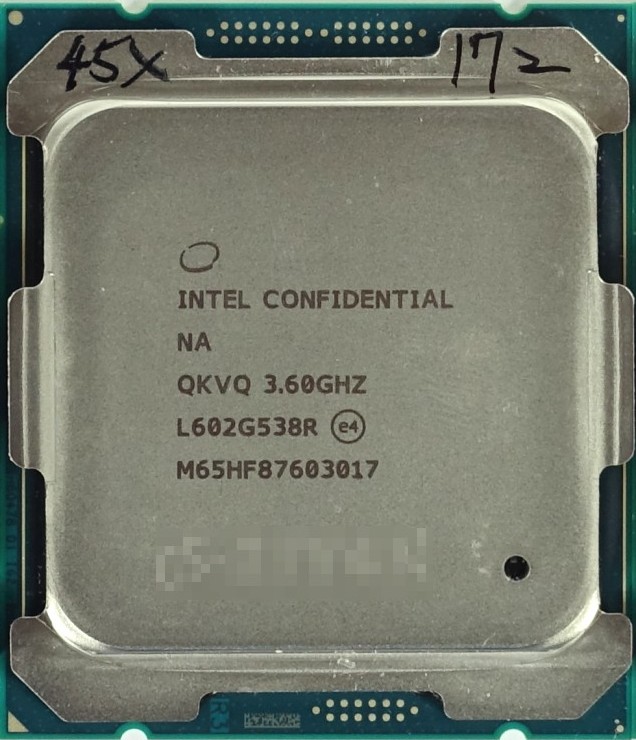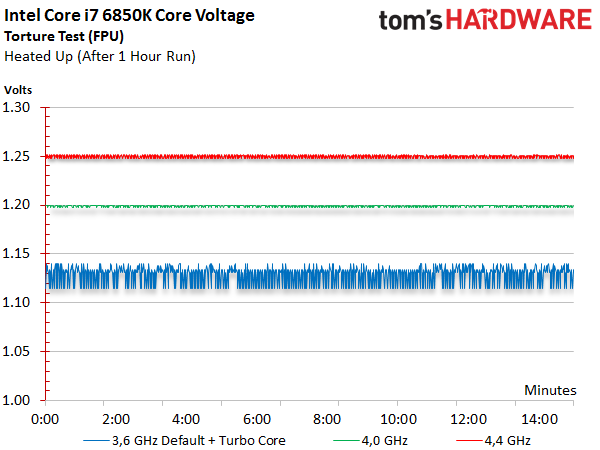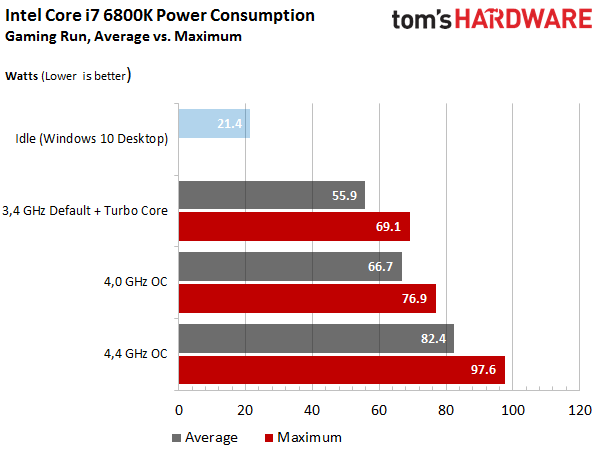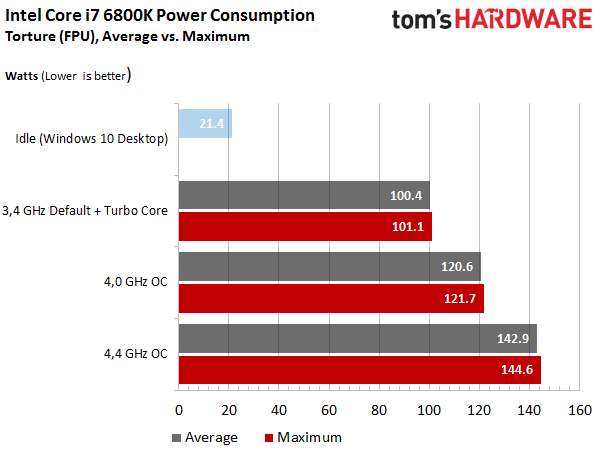Broadwell-E: Intel Core i7-6950X, 6900K, 6850K & 6800K Review
Is Broadwell more attractive to enthusiasts without graphics and up to 10 Hyper-Threaded cores? We test against two previous generations, plus Skylake to find out.
Intel Core i7-6850K: Overclocking, Power & Temperatures
Base Clock Frequency, Turbo Boost & Overclocking
Intel’s Core i7-6850K is only marginally faster than the -6800K. Again, its base clock rate is 3.6GHz and its maximum Turbo Boost frequency tops out at 3.8GHz, though we only saw our sample get up to 3.7GHz.
The highest stable overclock turned out to be the same 4.4GHz we recorded with the -6800K. If there's a silver lining, though, the core voltage need to achieve that frequency was 0.2V lower. In other words, there's quite a bit of variation between Broadwell-E CPUs in Intel’s new product line.
Once again, let’s take a look at the observed clock rates for the individual cores of all three frequency configurations we tested.
Core Voltage Necessary For A Stable Overclock
Overclocking gets interesting when we have more room to play with the core voltage due to a (supposedly) higher-quality processor. Now we can hit 4.4GHz at 1.25V instead of the -6800K’s 1.45V.
Now you may be thinking, as we did, that this frees up more overclocking headroom. We'd all be wrong. Our system did boot at 4.5GHz and 1.5V, but it was far from stable. Still, dropping the multiplier by 1x makes all the difference, facilitating complete stability at 4.4GHz.
Resulting Power Consumption
During our gaming loop, the stock Core i7-6850K’s power consumption comes in higher than the -6800K’s due to higher Turbo Boost frequencies. Once the clock rates are fixed, it becomes apparent that our Core i7-6850K isn’t all that great. Sometimes that's just what happens with engineering samples, even though this particular CPU is supposed to be from a current production run.
So what happens once the Core i7-6850K is pushed hard? It breaks past the 100W threshold, even though the increase is just 44 percent at 4.4GHz this time. That’s certainly a massive jump, but it does seem to be within reason for such a high overclock.
Get Tom's Hardware's best news and in-depth reviews, straight to your inbox.
Temperatures During Continuous Operation
We averaged the temperatures of each core, as reported by the sensors, just like before. The following gallery illustrates our measurements in the gaming loop and stress test, along with the water temperature.
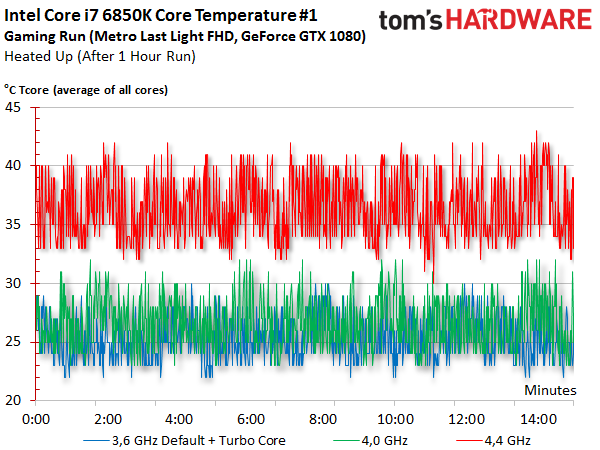
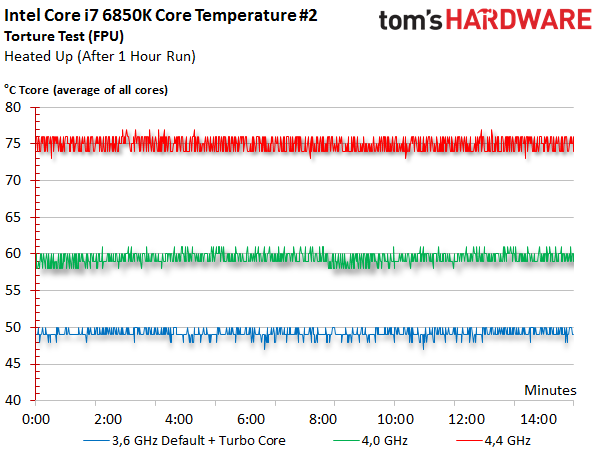
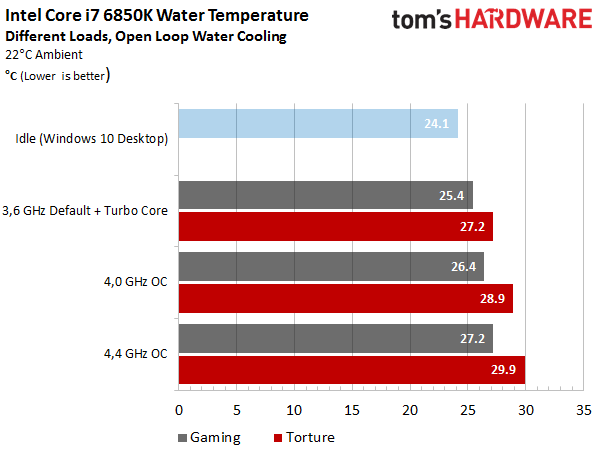
The Core i7-6850K’s readings are generally lower than those from the -6800K. This is hardly surprising in light of the lower core voltages. Air cooling could be possible up to 4.0GHz, though that’s cutting it close due to Broadwell-E’s higher density compared to Haswell-E.
Bottom Line
The stock Core i7-6850K stays just about as cool as its smaller sibling, achieving higher Turbo Boost clock rates while only drawing marginally more power. The overclocking results nicely demonstrate variations in processor quality, though we're again limited to an overclocking ceiling around 4.4GHz.
Overall, Intel's Core i7-6850K is a good processor. We would have loved a better-quality sample for our comparisons, though. Seeing that we don’t know where exactly Intel cuts corners with its least-expensive model, we’d be inclined to pick the -6850K over the -6800K.
MORE: Best CPUs
MORE: All CPU Content
MORE: Intel & AMD Processor Hierarchy
Current page: Intel Core i7-6850K: Overclocking, Power & Temperatures
Prev Page Intel Core i7-6800K: Overclocking, Power & Temperatures Next Page Intel Core i7-6900K: Overclocking, Power & Temperatures-
jt AJ was expecting a bit more info and review usage of turbo 3.0. also looks like most of broadwell E chip is junk.. except that one 6850k chip you received probably lucky 1.25v for 4.4v would be good thats only because its broadwell. got one here for 4.8ghz at just 1.22v.Reply -
Nuckles_56 Chris, how likely is it that a noctua NH-D15 would be able to cool these heat producing monsters if your h100i struggled and failed with the i7-6800k @4.4GHz.Reply
But a truly excellent review, even if it does show that there is little reason to go to broadwell-E over Haswell-E -
elho_cid I'd love to step up to the realm of higher core count, but given the results of Adobe SW when scaling to many threads, meas it is not really useful right now. :/Reply
That's a pity, because the most time I spend staring at a progress bar is when I'm using Adobe products. I don't really need more power to "background tasks" like zipping or lame encoding.
-
AdmiralDonut Standard SLI is not limited on the new NVIDIA cards. The only thing that's limited is the new High Bandwidth SLI. Normal 3 and 4-way SLI can be enabled easily by simply asking NVIDIA for an unlock code, something any half way serious enthusiast will most certainly do. Here's some more info on this matter:Reply
https://www.youtube.com/watch?v=2wBDt9tN5-c -
bit_user I don't really see the point of having a $1700 non-Xeon SKU. Of the few people who can afford it, even less would bother/dare to overclock it.Reply
I'm still wishing for the rumored 5 GHz SKU to surface. I've rarely needed more than 4 cores, but a couple extra GHz always comes in handy. Even so, I'll not be upgrading until at least Skylake-E or perhaps Kaby-E.
-
Cerunnir ReplyChris, how likely is it that a noctua NH-D15 would be able to cool these heat producing monsters if your h100i struggled and failed with the i7-6800k @4.4GHz.
But a truly excellent review, even if it does show that there is little reason to go to broadwell-E over Haswell-E
NH-D15 is arguably better or atleast equal to the H100i when it comes to cooling, and its noise levels is definatly lower both in load and while idle.
http://www.relaxedtech.com/reviews/noctua/nh-d15-versus-closed-loop-liquid-coolers/2 -
bit_user Reply
No. Buy a Xeon version, for that. It's practically the only difference. It's artificial product differentiation, known as "market segmentation".18045773 said:Does it have support for ECC ram?
Here, you can find links to the specs of the CPUs mentioned in this article: http://ark.intel.com/products/family/79318/Intel-High-End-Desktop-Processors#@Desktop If you view their individual specs, you can see that none support ECC.
Intel hasn't yet announced the E5-16xx v4 series CPUs, but you can turn up leaked specs with a bit of searching.
And you'll need motherboard support, too.
-
cats_Paw Good review (excellent if its only the heads up for a more in-depth one).Reply
I have to say that I would love to have a 6 or even 8 core CPU but these prices and performances dont add up.
In my country a 6700K and a 5820K are priced almost the same, but its still a hard choice (Do i want a "maybe" future proof 6 core that can be good for some work or a 4 core that is flat out faster and cheaper to build around for gaming?). -
pyoverdin Am I correct in saying I could build a PC that's 5 FPS off the 6950X for it's price?Reply
